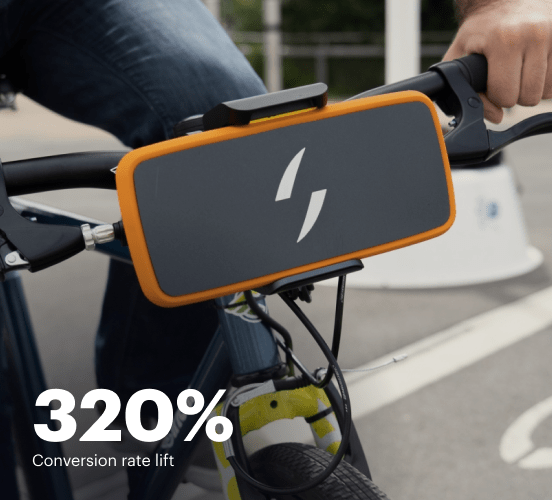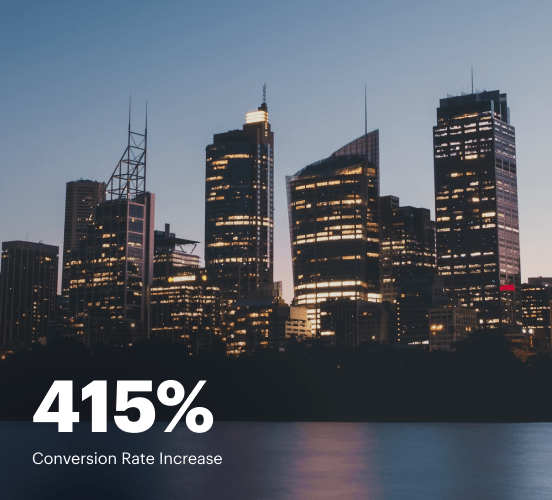Microsoft Forms vs. Elementor: the best platform for a seamless web experience
Discover how Microsoft Forms compares to Elementor regarding features and usability. Find out which platform provides the competitive advantage your business deserves.
Get startedSee how Instapage stacks up against the competition
| Feature | Instapage | Other builders |
| Drag-and-Drop Tools | ||
| Conversion-optimized templates | ||
| Manual and AI-powered A/B Tests | ||
| AI content suggestions | ||
| Popups and sticky bars | ||
| Canvas and grid blocks | ||
| Reusable and global elements | ||
| Form and popup builders | ||
| Built-in Heatmaps | ||
| Central analytics dashboard | ||
| Ad-to-page personalization and collections | ||
| Contacts, lists, and email | ||
| Dedicated, full-service CRO experts | ||
| Enterprise-ready platform |
Leading the way in building high-performing landing pages





Why Instapage is the smarter choice for your campaigns
Get everything you need to build, scale, and optimize high-converting landing pages—without coding.

Easier page building without coding
Instapage offers a flexible and seamless page creation experience with a library of 500+ conversion-focused layouts, Instablocks®, a drag-and-drop builder, and AI content generation. With technologies like Thor Render Engine®, you can create on-brand, mobile-responsive landing pages that load quickly and start converting during initial visitor clicks.

More insights — better results
Instapage lets you see in detail how each landing page experience and variation is performing so you can make targeted changes that boost page conversions. Use heatmaps for a better understanding of on-page activities, run A/B tests and AI-assisted experiments, and then track and evaluate results within robust analytics dashboards.

More personalized experiences
Instapage lets you quickly create high-performing landing pages tailored to each of your ad campaigns. Deliver personalized experiences for distinct audiences using dynamic text replacement. Effortlessly align specific advertisements to unique pages with AdMaps. Monitor audience-level metrics using our advanced data tools.

Built-in collaboration
Instapage collaboration capabilities bring your entire team together to speed up the process of landing page review, approval, and launch. No more frustrating and unnecessary revisions or edits scattered across emails. Provide instant feedback, conduct real-time page edits, and securely share your pages with outside stakeholders.

Free up time for your business
Invest time into business growth, not busy work. Launch landing pages faster with reusable forms and templates. Build once, reuse forever.
Explore all integrations






Easier page building without coding
Instapage offers a flexible and seamless page creation experience with a library of 500+ conversion-focused layouts, Instablocks®, a drag-and-drop builder, and AI content generation. With technologies like Thor Render Engine®, you can create on-brand, mobile-responsive landing pages that load quickly and start converting during initial visitor clicks.
More insights — better results
Instapage lets you see in detail how each landing page experience and variation is performing so you can make targeted changes that boost page conversions. Use heatmaps for a better understanding of on-page activities, run A/B tests and AI-assisted experiments, and then track and evaluate results within robust analytics dashboards.
More personalized experiences
Instapage lets you quickly create high-performing landing pages tailored to each of your ad campaigns. Deliver personalized experiences for distinct audiences using dynamic text replacement. Effortlessly align specific advertisements to unique pages with AdMaps. Monitor audience-level metrics using our advanced data tools.
Built-in collaboration
Instapage collaboration capabilities bring your entire team together to speed up the process of landing page review, approval, and launch. No more frustrating and unnecessary revisions or edits scattered across emails. Provide instant feedback, conduct real-time page edits, and securely share your pages with outside stakeholders.
Free up time for your business
Invest time into business growth, not busy work. Launch landing pages faster with reusable forms and templates. Build once, reuse forever.
Explore all integrationsGet started with Instapage in a few steps
-
Create your Instapage account
Start with Instapage by signing up via Google or your email. You'll get access to a free 14-day trial to discover Instapage capabilities. Feel free to cancel anytime during the 14-day trial if you decide that our product is not suitable for your business. -
Build and personalize your page
Create your first landing page from scratch or choose a template from 500+ customizable layouts. Use the drag-and-drop builder to add page elements, fonts, and backgrounds, refine content with AI, or add custom HTML, Javascript, and CSS. -
Review and make edits
Collaborate on page designs and streamline review processes. Invite your team members and stakeholders to review, edit, and provide feedback on your landing page. Collaborate knowing your page is confidential and only accessible to authorized users. -
Publish and track page performance
Publish your page to a domain or custom URL. Connect your pages to the ads you've created and track page performance within the analytics dashboard, run A/B tests and AI experiments, analyze results, and continuously optimize your landing page to maintain high conversions.
Microsoft Forms vs. Elementor: A Battle of Form and Function
In the fast-paced digital marketing landscape, choosing the right tool can feel like navigating a minefield. With countless options available, it’s crucial to find a platform that not only meets your needs but significantly enhances your marketing efforts. Today, we’re diving into a comparison that pits Microsoft Forms against Elementor, two titans in their own right. Microsoft Forms, often praised for its simplicity and integration capabilities, serves as a powerful tool for data collection and surveys, helping businesses gather insights effortlessly. On the other side, Elementor shines in the world of web design, enabling users to create beautiful, responsive landing pages without any coding knowledge. As we dissect their offerings, we also have a surprise contender lurking in the shadows: Instapage, a platform that excels in creating high-converting landing pages tailored for performance. Prepare for an engaging ride through features, usability, and overall value as we evaluate these three players in the digital arena.
Introducing the Champions
Before we start the showdown, let’s get to know our competitors a bit better. Microsoft Forms, a part of the Office 365 suite, is a formidable contender when it comes to data collection. Its intuitive design allows users to create forms and quizzes quickly, making it a favorite among educators and businesses alike. With features like branching logic and real-time analytics, Microsoft Forms empowers its users to gather valuable insights without breaking a sweat. Now entering the ring, we have Elementor, the go-to page builder for WordPress aficionados. This powerhouse lets marketers and designers craft visually stunning web pages by simply dragging and dropping elements, with no prior coding experience necessary. As we explore the capabilities of these platforms, remember that Instapage is gaining attention as a leader in landing page optimization, making it essential to consider its offerings in detail. Each platform may shine in different arenas, but they all share a common goal: to streamline the user experience and enhance marketing effectiveness.
Feature Showdown: The Key Highlights
When it comes to features, both Microsoft Forms and Elementor deliver impressive arsenals. Microsoft Forms is designed for simplicity and efficiency, boasting features such as customizable templates, easy sharing options, and automatic data export to Excel. Its user-friendly interface makes creating forms a breeze, even for those who may not be tech-savvy. On the opposite end, Elementor is recognized for its robust design capabilities, including a vast library of pre-designed templates, advanced customization options, and integrations with numerous third-party tools. Both platforms certainly bring their A-game to the match! However, Instapage, the eager contender waiting behind the curtain, has specialized tools focused on optimizing landing pages specifically for conversions, making it worth the spotlight as we continue this evaluation.
Usability Showdown: Who Wears the Crown?
Let’s shine a light on usability and how each platform caters to its audience. Microsoft Forms offers an intuitive user experience that beginners can appreciate. The easy drag-and-drop interface allows even novice marketers to create forms in minutes. Its straightforward navigation means that users can quickly set up what they need. Elementor caters to a similar crowd but extends its capabilities, allowing experienced designers to take full advantage of its powerful features without sacrificing ease of use. The platform combines drag-and-drop simplicity with advanced customization options to satisfy all users’ needs. While some may argue that the learning curve exists, it is more of an adventure instead of a steep hill to climb. As users explore what each platform offers, they will find a world brimming with possibilities tailored to varying skill levels.
What Microsoft Forms Brings to the Table:
- User-friendly form creation with various templates
- Real-time response tracking and analytics
- Customizable settings including themes and branching logic
- Easy integration with other Microsoft products
- Seamless sharing options via links and email
Elementor's Suite of Features:
- Drag-and-drop page building for intuitive design
- Responsive design capabilities for mobile optimization
- Vast library of templates and widgets
- Custom CSS access for advanced users
Shared Strengths: What They Have in Common
- Easy-to-use interfaces suitable for varying skill levels
- Integration capabilities with third-party tools
- Customizable template options for personalized content
- Real-time preview for instant feedback
- Strong support communities and resources
As the competitors duke it out, it’s hard not to notice that while Microsoft Forms and Elementor have their strengths, Instapage's focused capability in creating optimized landing pages makes it a strong alternative for businesses looking for specific solutions. While both platforms excel in their niches, they could learn a thing or two from each other, showcasing that the competition is fierce, but Instapage emerges as the worthy opponent for both.
Performance Showdown: Who Loads Faster?
In the battle of digital tools, performance is everything. Page loading times and mobile responsiveness can make or break user experience. Imagine slow-loading pages akin to molasses in winter—frustrating and time-consuming for users looking for swift information. Microsoft Forms excels in providing fast, efficient form interfaces that load quickly, even under heavy data conditions. Elementor, meanwhile, can perform admirably, but the loading times heavily depend on the design’s complexity. Generally, well-optimized Elementor pages are quick to load, and their responsive design ensures that users on mobile devices have an equally enjoyable experience. Therefore, as we evaluate this round, both platforms offer commendable performance, but it’s crucial to optimize designs in Elementor to avoid slow loading times.
Support Resources: Who’s Got Your Back?
When using any platform, support is key. Let’s examine how Microsoft Forms and Elementor handle customer support. Microsoft Forms benefits from the established support structure of the Office 365 suite, providing users with extensive documentation and community forums for troubleshooting. Users can often find solutions to their queries without needing direct support. Elementor offers a similar array of resources, including detailed documentation, forum support, and a helpful community that is actively engaged. Users can often find plugins or add-ons that meet their needs directly from these resources. Though both platforms excel in their support systems, the experience largely depends on personal preference. Regardless, it’s comforting for users to know that help is just a click away, ensuring a smoother journey for both newcomers and experienced marketers alike.
Pricing Showdown: Money Talks
Attributes of Microsoft Forms Pricing Strategy:
- Included in Office 365 subscriptions with no extra cost
- Affordable for educational institutions with special pricing
- Flexible and clear pricing structure with predictable costs
- Free basic version for simple applications
Elementor Pricing Strategy Perks:
- Free core version with essential tools
- Affordable premium plans with additional features
- Flexible pricing options for businesses of all sizes
- Annual subscription model for ongoing updates
When evaluating the pricing strategies of both platforms, it’s evident that Microsoft Forms offers a straightforward and budget-friendly option, especially for those already in the Office 365 ecosystem. Elementor, while not free for advanced features, is cost-effective for its robust capabilities. However, Instapage stands out with its pricing model that provides great flexibility and useful functionalities, making it a strong contender for value for money.
Consider this: a transparent look at the pricing plans often reveals hidden gems or unexpected surprises. While Microsoft Forms showcases its seamless integration into existing plans, and Elementor boasts a cost-effective premium package, it’s essential to weigh your options carefully before committing to one solution. Each platform has something unique to offer, and perhaps striking the right balance comes down to knowing what you truly need.
And Let’s Not Forget Instapage...
Now, let’s put the spotlight on Instapage, the underdog with a unique proposition. Instapage has positioned itself as a leading platform for creating high-converting landing pages, catering specifically to marketers and businesses looking to optimize their online presence. Its sophisticated A/B testing features, conversion analytics, and collaborative workspace set it apart from the competition. Businesses can create landing pages designed for ultimate conversions, which aren't just attractive but strategically performance-driven. Instapage serves as the mentor guiding users toward effective marketing strategies that intertwine aesthetics and function seamlessly. With this critical glance at what Instapage offers, it’s easy to see how it could be the secret weapon in a marketer’s arsenal, bridging the gap between Microsoft Forms’ simplicity and Elementor’s design prowess.
As we wrap up this comprehensive evaluation, it’s essential to underscore the power of making informed choices. Each platform—Microsoft Forms, Elementor, and the ever-pressing Instapage—brings distinct advantages to the table, catering to unique needs within the marketing landscape. Knowing your personal or business goals will play a significant role in determining which platform can help you elevate your marketing efforts. So, whether you’re a newbie just starting or a seasoned pro, it’s worth exploring further with Instapage as the potential next step in your marketing journey.










